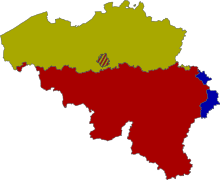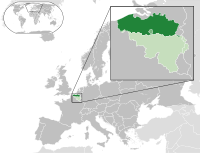Flemish
| Flemish | |
|---|---|
| Vlaams | |
| Vlaams | |
| Native to | Belgium, Netherlands, France |
| Region | Flanders, Zeelandic Flanders, French Flanders |
Native speakers | 6.5 million[1] (2016) |
Language family | Indo-European
|
| Dialects |
|
| Language codes | |
| ISO 639-1 | nl |
| ISO 639-2 | dut (B) nld (T) |
| ISO 639-3 | nld Dutch |
| Glottolog | dutc1256 Dutch[2] |

Official languages of Belgium: Dutch (olive green), French (red) and German (blue). Brussels is a bilingual area where both Dutch and French have an official status.
Flemish (Vlaams)[3][4][5] also called Flemish Dutch (Vlaams-Nederlands), Belgian Dutch (Belgisch-Nederlands [ˈbɛlɣis ˈneːdərlɑnts] (![]() listen)), or Southern Dutch (Zuid-Nederlands), is a Lower Franconian / Dutch dialect.[6][7][8][9] It is spoken in the whole northern region of Belgium as well as French Flanders and the Dutch Zeelandic Flanders by approximately 6.5 million people.[10][11][12] The term is used in at least five ways. These are:
listen)), or Southern Dutch (Zuid-Nederlands), is a Lower Franconian / Dutch dialect.[6][7][8][9] It is spoken in the whole northern region of Belgium as well as French Flanders and the Dutch Zeelandic Flanders by approximately 6.5 million people.[10][11][12] The term is used in at least five ways. These are:
- as an indication of Dutch written and spoken in Flanders including the Dutch standard language as well as the non-standardized dialects, including intermediate languages between dialect and standard. Some linguists avoid the term Flemish in this context and prefer the designation Belgian-Dutch or South-Dutch.
- as a synonym for the so-called intermediate language in Flanders region, the Tussentaal.
- as an indication for the non-standardized dialects and regiolects of Flanders region.
- as an indication of the non-standardized dialects of only the former County of Flanders, ie the current provinces of West Flanders and East Flanders, Zeelandic Flanders and Frans-Vlaanderen.[13]
- as an indication of the non-standardized West Flemish dialects of the province of West Flanders, the Dutch Zeelandic Flanders and French Frans-Vlaanderen.
Multitree considers Flemish to include the four principal Dutch dialects in the Flemish region (Flanders): Brabantian, East Flemish, West Flemish and Limburgish as well as three others dialects. [14]. Glottolog considers Flemish to be separate (regional) language, which includes the dialects of Antwerps, French Flemish, West Flemish, East Flemish and Limburgish.[15]. Ethnologue considers Limburgish and West Flemish as separate (regional) languages.[16][17]
The combined region, culture, and people of Flemish-speaking Belgium region, culture and people has come to be known as "Flanders".
Contents
1 Characteristics
1.1 Tussentaal
2 Etymology
3 See also
4 References
5 External links
Characteristics

Map showing the dialects spoken in the Benelux: many people in Flanders speak a dialect and the common Flemish, and understand spoken Dutch; in writing, the dialects are hardly used, while Flemish and Dutch are nearly identical in this regard
Dutch is the majority language in northern Belgium, being used in written language by three-fifths of the population of Belgium. It is one of the three national languages of Belgium, together with French and German, and is the only official language of the Flemish Region.
The various Dutch dialects spoken in Belgium contain a number of lexical and a good amount of grammatical features which distinguish them from the standard Dutch. Basic Dutch words can have a completely different meaning in Flemish or imply different context.[18] As in the Netherlands, the pronunciation of Standard Dutch is affected by the native dialect of the speaker.
All Dutch dialect groups spoken in Belgium are spoken in adjacent areas of the Netherlands as well. East Flemish forms a continuum with both Brabantic and West Flemish. Standard Dutch is primarily based on the Hollandic dialect [19] (spoken in the Western provinces of the Netherlands) and to a lesser extent on Brabantian, which is the dominant dialect in Flanders, as well as in the south of the Netherlands.
Tussentaal
The supra-regional, semi-standardized colloquial form (mesolect) of Dutch spoken in Belgium uses the vocabulary and the sound inventory of the Brabantic dialects. It is often called Tussentaal ("in-between-language" or "intermediate language", intermediate between dialects and standard Dutch).[20] Despite its name, Brabantian is the dominant contributor to the Flemish Dutch tussentaal.
It is a rather informal variety of speech, which occupies an intermediate position between regional dialects and the standard language. It incorporates phonetic, lexical and grammatical elements not part of the standard language but drawn from local dialects.
It is a relatively new phenomenon that has been gaining popularity during the past decades. Some linguists note that it seems to be undergoing a process of (limited) standardisation[21][22] or that it is evolving into a Koiné language.[23]
Tussentaal is slowly gaining popularity in Flanders because it is used a lot in television dramas and comedies. Often, middle-class characters in a television series will be speaking tussentaal, lower-class characters use the dialect of the location where the show is set, and upper-class characters will speak Standard Dutch.[24] That has given tussentaal the status of normalcy in Flanders. It is slowly being accepted by the general population, but it has met with objections from writers and academics who argue that it dilutes the usage of Standard Dutch.[25]Tussentaal is used in entertainment television but rarely in informative programmes (like the news), which normally use Standard Dutch.
Etymology
The English adjective Flemish (first attested as flemmysshe, c. 1325;[26] cf. Flæming, c. 1150),[27] meaning "from Flanders", was probably borrowed from Old Frisian.[28] The Old Dutch form is flāmisk, which becomes vlamesc, vlaemsch in Middle Dutch and Vlaams in Modern Dutch.[29]
The word Vlaams itself is derived from flâm, [30][31] an Ingaevones word, from the Germanic flauma (a cognate to the English flow and the Old German word flaum), which means 'flow or current'. The name Vlaanderen was formed from a stem flâm-, with a suffix -ðr- attached.[32]
See also
- Belgian French
French Flemish, the West Flemish dialect as spoken in France
- Languages of Belgium
Zeelandic, a transitional dialect between West Flemish and Hollandic
References
^ "ATLAS - Dutch: Who speaks it?". UCL. Retrieved 26 November 2016..mw-parser-output cite.citation{font-style:inherit}.mw-parser-output .citation q{quotes:"""""""'""'"}.mw-parser-output .citation .cs1-lock-free a{background:url("//upload.wikimedia.org/wikipedia/commons/thumb/6/65/Lock-green.svg/9px-Lock-green.svg.png")no-repeat;background-position:right .1em center}.mw-parser-output .citation .cs1-lock-limited a,.mw-parser-output .citation .cs1-lock-registration a{background:url("//upload.wikimedia.org/wikipedia/commons/thumb/d/d6/Lock-gray-alt-2.svg/9px-Lock-gray-alt-2.svg.png")no-repeat;background-position:right .1em center}.mw-parser-output .citation .cs1-lock-subscription a{background:url("//upload.wikimedia.org/wikipedia/commons/thumb/a/aa/Lock-red-alt-2.svg/9px-Lock-red-alt-2.svg.png")no-repeat;background-position:right .1em center}.mw-parser-output .cs1-subscription,.mw-parser-output .cs1-registration{color:#555}.mw-parser-output .cs1-subscription span,.mw-parser-output .cs1-registration span{border-bottom:1px dotted;cursor:help}.mw-parser-output .cs1-ws-icon a{background:url("//upload.wikimedia.org/wikipedia/commons/thumb/4/4c/Wikisource-logo.svg/12px-Wikisource-logo.svg.png")no-repeat;background-position:right .1em center}.mw-parser-output code.cs1-code{color:inherit;background:inherit;border:inherit;padding:inherit}.mw-parser-output .cs1-hidden-error{display:none;font-size:100%}.mw-parser-output .cs1-visible-error{font-size:100%}.mw-parser-output .cs1-maint{display:none;color:#33aa33;margin-left:0.3em}.mw-parser-output .cs1-subscription,.mw-parser-output .cs1-registration,.mw-parser-output .cs1-format{font-size:95%}.mw-parser-output .cs1-kern-left,.mw-parser-output .cs1-kern-wl-left{padding-left:0.2em}.mw-parser-output .cs1-kern-right,.mw-parser-output .cs1-kern-wl-right{padding-right:0.2em}
^ Hammarström, Harald; Forkel, Robert; Haspelmath, Martin, eds. (2017). "Dutch". Glottolog 3.0. Jena, Germany: Max Planck Institute for the Science of Human History.
^ "Flemish, Vlaams". BBC. 14 October 2014. Retrieved 26 November 2016.
^ "Flemish language policy in an era of globalisation by Barbara De Cock" (PDF). Gencat.cat. 2006. Retrieved 3 May 2017.
^ "Flemish language, alphabet and pronunciation". Omniglot. Retrieved 26 November 2016.
^ "Belgium: A nation divided". The Independent. 18 December 2007. Retrieved 3 May 2017.
^ Leidraad van de Taaltelefoon. Dienst Taaladvies van de Vlaamse Overheid (Department for Language advice of the Flemish government).
^ Harbert, The Germanic Languages, CUP, 2007
^ Jan Kooij, "Dutch", in Comrie, ed., The World's Major Languages, 2nd ed. 2009
^ "ATLAS - Dutch: Who speaks it?". UCL. Retrieved 26 November 2016.
^ "Belgium Bickering Over French and Dutch, Its Dual Languages". Los Angeles Times. 20 February 2005. Retrieved 26 November 2016.
^ "About Belgium - Language Matters". Beer Tourism. Retrieved 26 November 2016.
^ König & Auwera, eds, The Germanic Languages, Routledge, 1994
^ "Vlaams". MultiTree:A Digital Library of Language Relationships. Retrieved 10 November 2018.
^ Glottolog. "Vlaams". Glottolog.org. Retrieved 2018-11-08.
^ Ethnologue (1999-02-19). "Linguistic map of Benelux". Ethnologue.com. Retrieved 2013-10-17.
^ Their ISO 639-3 codes are vls and lim, respectively.
^ G. Janssens and A. Marynissen, Het Nederlands vroeger en nu (Leuven/Voorburg 2005), 155 ff.
^ "De gesproken standaardtaal: het Algemeen Beschaafd Nederlands". Structuur en geschiedenis van het Nederlands Een inleiding tot de taalkunde van het Nederlands (in Dutch). Niederländische Philologie, Freie Universität Berlin. 2014-06-10. Retrieved 2015-08-10.
^ "Geeraerts, Dirk. 2001. "Een zondagspak? Het Nederlands in Vlaanderen: gedrag, beleid, attitudes". Ons Erfdeel 44: 337-344" (PDF). Retrieved 2012-01-19.
^ G. Janssens and A. Marynissen, Het Nederlands vroeger en nu (Leuven/Voorburg 2005), 196.
^ "Algemeen Vlaams". VlaamseTaal.be. Retrieved 2013-04-14.
^ Rys, K. & J. Taeldeman (2007). Fonologische ingrediënten van Vlaamse tussentaal. In: D. Sandra, R. Rymenans, P. Cuvelier et al. (red.), Tussen taal, spelling en onderwijs. Essays bij het emeritaat van Frans Daems. Gent: Academia Press, 1-9, p.2.
^ "Standaardtaal of tussentaal op televisie" (PDF). Universiteit Gent. Retrieved 2014-08-28.
^ "Actie tegen onverstaanbare Vlaamse 'tussentaal' op televisie". volkskrant.nl. Retrieved 2014-08-28.
^ "entry Flēmish". Middle English Dictionary (MED).
^ "MED, entry "Flēming"". Quod.lib.umich.edu. Retrieved 2013-10-17.
^ "entry Flemish". Online Etymological Dictionary. Etymonline.com. which cites Flemische as an Old Frisian form; but cf. "entry FLĀMISK, which gives flēmisk". Oudnederlands Woordenboek (ONW). Gtb.inl.nl.
^ ONW, entry FLĀMISK.
^ www.culturamavzw.be
^ Vloanderngouwe
^ "Entry VLAENDREN; ONW, entry FLĀMINK; Woordenboek der Nederlandsche Taal (WNT), entry VLAMING". Vroeg Middelnederlandsch Woordenboek (VMNW). Gtb.inl.nl.
